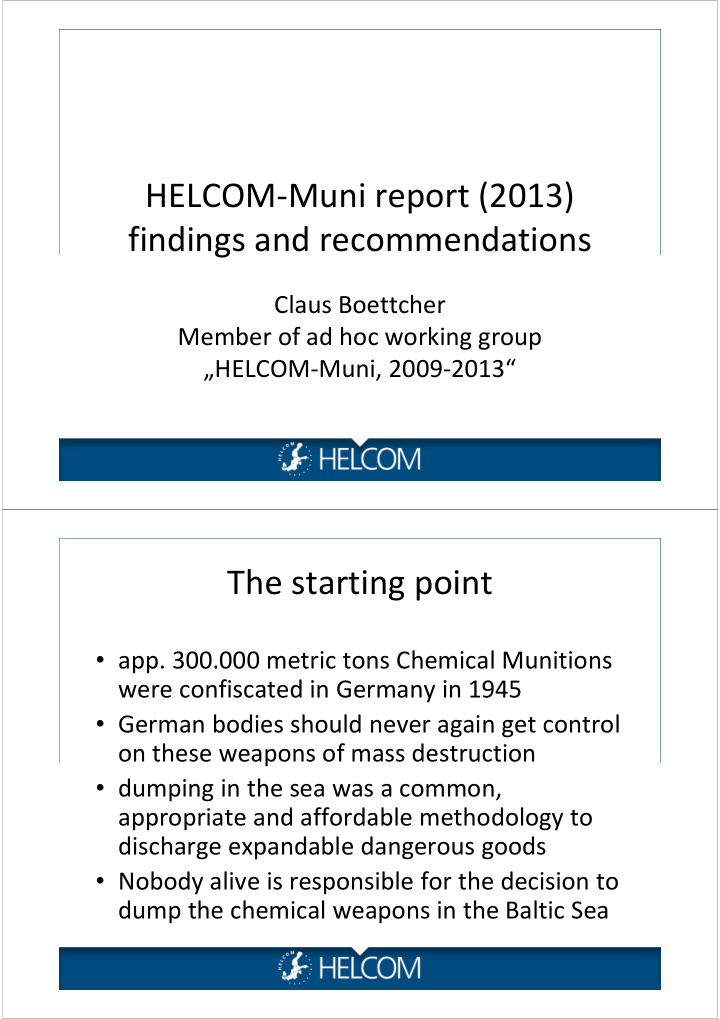



HELCOM ‐ Muni report (2013) findings and recommendations Claus Boettcher Member of ad hoc working group „HELCOM ‐ Muni, 2009 ‐ 2013“ The starting point • app. 300.000 metric tons Chemical Munitions were confiscated in Germany in 1945 • German bodies should never again get control on these weapons of mass destruction • dumping in the sea was a common, appropriate and affordable methodology to discharge expandable dangerous goods • Nobody alive is responsible for the decision to dump the chemical weapons in the Baltic Sea
Munitions in principle Chemical warfare conventional chemical agent (CWA) Explosives (Fuse) Mustard gas ejection mine (DE)
Stock pile in south Germany Example: dumping peace by peace (on target and on route) Source: http://cdn.morichesdaily.com/wp-content/uploads/2010/07/dumping.jpg/
Example: Object on seabed Fifty five gallon drum on seabed off San Francisco Source: esciencenews.com Questions • Did humans got in contact with CWA? • What about sea live? • How does „the environment“ interact with CWA? • Does CWA stay in former dumping grounds? • What do we really know, from a scientific perspective of present knowledge?
Available data • Documentation of manufacturing, distribution and dumping of CW material (e.g. in Archives on national, regional and local level) • Former reports, e.g. HELCOM ‐ Chemu (1994/1995) • Sea charts and navigational broadcasts • Results of former projects, e.g. interactive map of former dumping sites with CW material: http://cns.miis.edu/stories/090806_cw_dumping.htm , … HELCOM 1994/1995 • 40.000 metric tons dumped chemical warfare (CW) material • containing app. 13.000 t of chemical warfare agents (CWA) • former dump sites – Gotland basin – Bornholm basin – Little Belt • Hazards: limited • Risk management: difficult
Behavior in the Marine Environment (1994) • Investigations of the behavior of warfare agents under Baltic Sea conditions exist only for a few substances. – […], their behavior can often only be described qualitatively; – details of the rates at which the processes occur are mostly missing. • Almost all warfare agents are broken down at varying rates into less toxic, water ‐ soluble substances. Scope of HELCOM MUNI tasks (2010 ‐ 2013)
Conferences and meetings • 2010: Decision of Ministerial Meeting in Moscow • Hosts of group work 2010 to 2013: – Germany, Poland, Latvia, Russia, and Denmark. • 2013: Report published as background paper to Ministerial Meeting in Copenhagen CWA characteristics
Profiles of former dumping sites New HELCOM maps http://www.helcom.fi/baltic ‐ sea ‐ trends/data ‐ maps/
1994/1995 vs. 2013 in brief Chemu (1994/1995) Muni (2013) • 40.000 metric tons dumped • 40.000 metric tons dumped • containing app. 13.000 t of • Containing 16.000 t of CWA CWA (40% of munitions) • former dumping sites • More dumping sites – Gotland basin – Germany – Bornholm basin – Poland – Little Belt • New hazards due to • Hazards: limited increasing use of seafloor • Risk management: • More and better options to difficult manage the risk In better detail • Activities since 1995 – Member states of HELCOM – Others: e.g. EU, UN ‐ General Assembly, OPCW • Risk management – Fulfillment of recommendations – Development of marine technology • Science – Recent findings e.g. in history, natural science and oceanology.
Activities since 1995 (examples) • Member states of HELCOM – investigations on national level – Public (media) interest has increased • EU – Scientific projects MERCW and CEMSEA • OPCW – side events to Int. Dialogue on underwater munitions (IDUM) • UN – Resolution in 2010, 65th session of the UN General Assembly Resolution A/RES/65/149: ‘Cooperative measures to assess and increase awareness of environmental effects related to waste originating from chemical munitions dumped at sea’ (cf. Chapter 2.3.1.2.2).’ Risk management • Fulfillment of recommendations – Statistical data available now (voluntary base) – Recommended surveys were undertaken • Development of marine technology – technicians cut a pipe remotely operated in 1.500 Meter deep Gulf of Mexico – Public eye witnessed this process on TV – ROV, AUV, SSS, Magnetometers, … • Risk Management Methodology – ISO 31000 (2009) and EU TGD, 2003
Science • Recent findings e.g. – History: new sources in archives – natural science • Mathematical models of the Baltic Sea • New methodology to sample and analyze • Better understanding of biological observations – Oceanology • Improved methodology to survey sea bottom • devices to measure quantity of certain effects Recommendations
Investigate • Historical research – Review archives: There are newly available documents, use state of the art methodology to analyze the available information • Technical investigation – Collect data to increase data about distribution and status of Chem. Munitions • Research transfer – Publish public information – Organize conferences to share information Manage • Analytical capability – eco ‐ toxicology, physico ‐ chemistry • Periodic surveys – development suitable guidelines for carrying out surveys and testing methods • Risk assessment – support and facilitate the development of suitable instruments and methods for site ‐ specific risk assessments. • Recovery (intential and unintential) – transfer procedures and experiences for intentional recovery – response teams should be deployed and work under common “best practice” operating procedures
Risk management Inform • Document Updating – consider this report as a step in an on ‐ going process • Public Awareness – support and facilitate the development and operation of information portals and other relevant measures to increase public awareness • Knowledge Provision • New Guidelines • Up ‐ to ‐ date Navigational Charts
Public information [DE] www.underwatermunitions.de White Phosphorous on beaches • No CWA but really a factor according to incidents on beaches of southern Baltic Sea.
about HELCOM ‐ Submerged Speaker • Mr. Claus Böttcher German Program on Underwater Munitions • Ministry of Energy, Agriculture, Environment and Rural Areas State of Schleswig ‐ Holstein, Mercatorstraße 3, 24106 Kiel, GERMANY • Telephone: +49 431 988 ‐ 3450 / ‐ 3460 • eM@il: claus.boettcher@melur.landsh.de
Recommend
More recommend